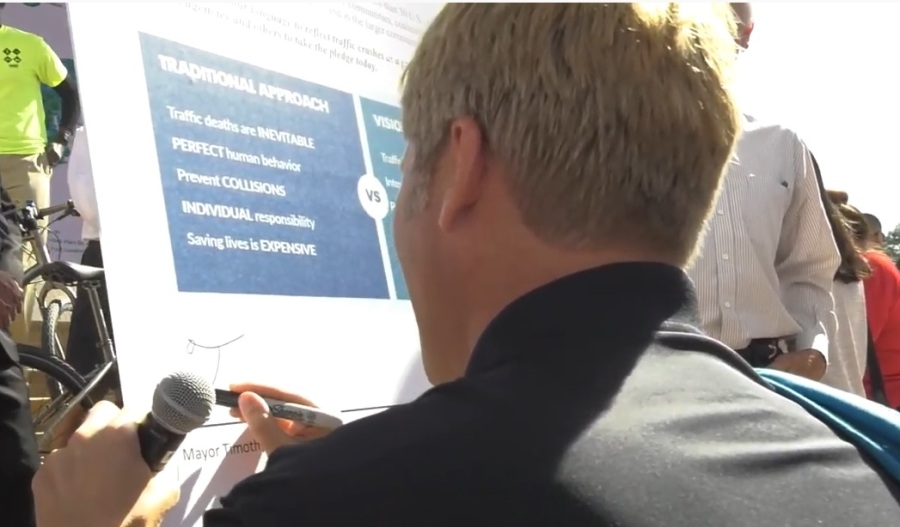A huge obstacle in fulfilling the “Vision Zero” pledge signed by Albuquerque Mayor Tim Keller in May of 2019 continues to be gaps and victim blaming biases in our fatal/injury crash reporting and investigations. To reduce the number of those killed on our roadways we need solid understanding and data into what is causing these incidents.

Unfortunately, the methods we currently use to examine factors do not provide sufficient understanding. Data gathered from these reports is, as a result, frustratingly worthless. This is especially true when looking at pedestrian fatality cases.
Take, for example, the case of Layla Zaragoza.
Ms. Zaragoza was killed May 1, 2019, a few days before Mayor Keller signed ABQ’s Vision Zero pledge, trying to cross Central Avenue at San Pablo Street. As with so many pedestrian cases, there are many factors one must consider if using this case as a tool to significantly reduce traffic fatalities ala Vision Zero.
Dismayingly, the Albuquerque Police Department’s investigatory conclusion in the “Supplementary Offense Report” for the case disregards other factors outlined below and instead just paints this as a case of…

In short: Zaragoza tried to cross Central at night wearing dark clothes at a intersection without a “designated crosswalk.” Nothing more to examine here. Move along.
But there are other things to consider in this case. These include the following details found elsewhere in the crash report, yet nowhere in the investigation’s conclusion above:
- Pointedly, the driver is never mentioned in the conclusion above.
- The driver who struck Ms. Zaragoza admits elsewhere in the record to taking “four hits of marijuana one hour prior to the wreck.” A field sobriety test is given, the same tests given those suspected of alcohol impairment, and he “passes.” The driver is thus deemed “not impaired.” As outlined in this recent ABQ Journal story on how the Rio Rancho Police Department is trying to sophisticate efforts to find impairment from marijuana and other drugs, these processes are very much still in a development phase.
- The driver also has a suspended driver’s license, the result of several traffic citations including speeding 21-25 miles over the speed limit.
- No objective examination of the driver’s vehicular speed at the time of the incident is collected (e.g., through examination of the vehicle’s “black box”). Instead, speed is determined by asking the driver, who self-reports driving “40-45 mph” at the time.
- The posted speed limit on this stretch of Central is 35 mph.
- Attempts are made to gather information from witnesses, but these are ultimately unsuccessful
- The “off set” intersection of Central and San Pablo (off set as San Pablo entrances to Central are not in a parallel line) and environs have some of the highest pedestrian usage rates in the city. This stretch of Central also has one of the highest pedestrian fatality rates in the city.
- One of many, many reasons for this is the great distance between “designated crosswalks” along this stretch.
- The nearest “designated crosswalk” to San Pablo’s west is Louisiana Blvd., ~1550 feet away. At the established walking rate found in governmental regulations for things like crosswalk timing of 3.5 feet per second, it takes the average person 443 seconds or 7.38 minutes to walk from San Pablo to Louisiana.
- The nearest “designated crosswalk” to San Pablo’s west is Pennsylvania St., ~1100 feet away. A person walking at the typical rate needs over 5 minutes to get from San Pablo to Pennsylvania.
It is also necessary to look at societal factors in any serious attempt to reduce traffic fatalities. Why are so many people walking along/across this stretch of Central at night? What is the condition of their behavioral health? What could be done to address any dangerous behaviors that could lead these walkers to be killed on this stretch of Central?
These questions are not within the scope of the Albuquerque Police Departments and its crash reports/investigations. Nevertheless, all of the factors outlined above, behavior included, must be examined by some governmental entity if we are to truly work toward “Vision Zero.” Not doing so makes Mayor Keller signing that “pledge” merely theatrics.
Driving speed is entirely within the scope of what APD should fully investigate in every fatal/injury crash. Speed is also considered the single most important factor in roadway deaths and major injuries. We’re never going to get anywhere near “Vision Zero” if police investigations of speed are summed up by merely asking the driver how fast they were going.
Inadequate police investigation of pedestrian fatality cases is hampering understanding and data collection that can lead to true implementation of Vision Zero policies. What boils down to simple victim-blaming, as in the case of Layla Zaragoza, only harms our work to reduce traffic deaths.

Please contact me. I am Layla’s mother and need some answers. Thank you
LikeLike
The roadway is six separate traffic streams. Pedestrians/Bikes/Cars/Cars/Bikes/Pedestrians
Right now spending is on car traffic and to a much leser degree bike traffic and pedestrian traffic is a much distant third.
Moderb lighting as opposed to the current puddle lighting is a common factor that will be transformational. Directed LED lighting fitted to the six traffic streams is a solution to puddle lighting that leaves dangerous areas of darkness., where a large number of accidents occur.
LikeLike